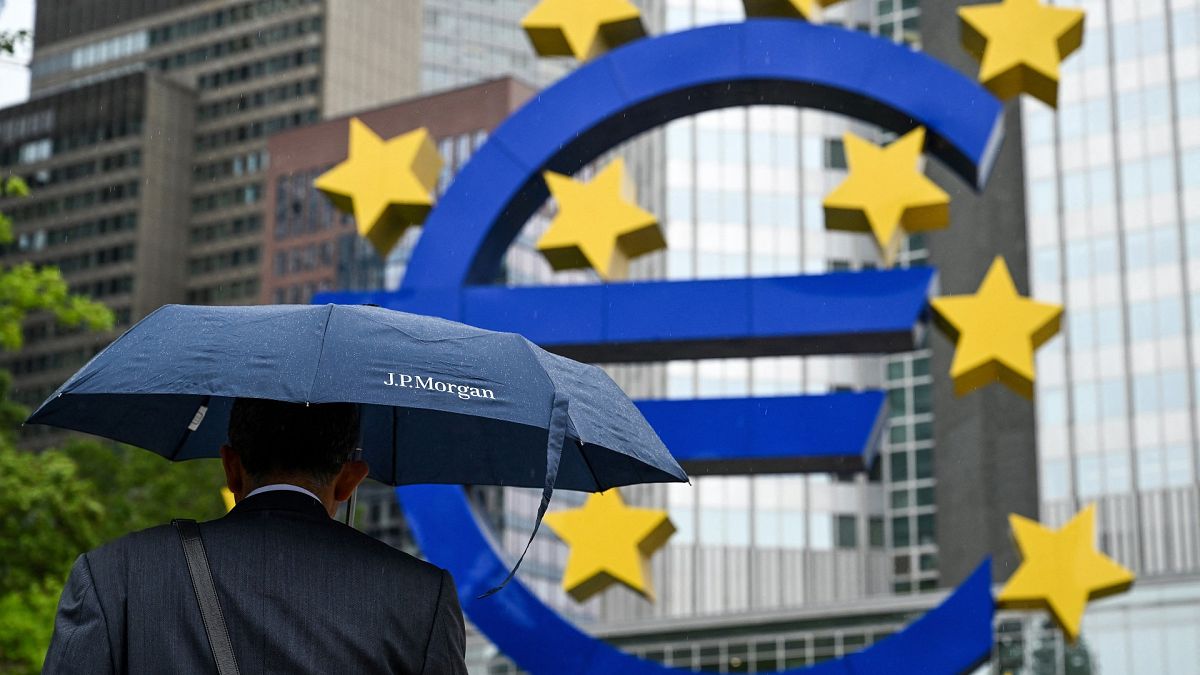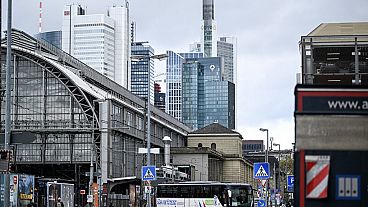Euronews Business spoke to chief EMEA economist, Sylvain Broyer, at S&P Global about the eurozone economic outlook for 2024.
The eurozone economy is likely to achieve a soft landing in the first quarter of next year, Sylvain Broyer said when delving into the company’s recently released Q1 2024 economic outlook reports for the eurozone and the UK.
Rising real incomes are expected to be one of the biggest drivers of this soft landing narrative, as disinflation progresses, and robust wage growth persists, further bolstering consumer spending. S&P Global expects eurozone inflation to be around 2.9% in 2024, with wage growth clocking in at about 4%, down from 5% in 2023.
A solid private sector balance sheet is also adding to the soft landing expectation, with the eurozone private sector currently having a net financing capacity of 4.5% of its gross domestic product. This is around 0.6% more than government financing needs require, creating a nice safety net if economic recovery struggles.
A third supporter of the soft landing scenario is strong financing conditions, with the majority of European banks and financial institutions having handled interest-rate risks admirably. The European real estate sector has also been supported by an increasing number of fixed-rate mortgages.
Thus S&P Global expects the eurozone economy to grow by about 0.8% in 2024, a slight decrease from its earlier guidance of 0.9%, but still broadly in line with expectations. This is also reliant on the European Central Bank cutting interest rates sometime in 2024, once inflation has abated more.
What are the risks to this soft landing?
There are a few external risks to this scenario, including European and international politics, as well as ongoing geopolitical happenings, as well as economic risks.
Amongst these, the resilience of the labour market continues to be one, with signs of the labour market now turning, with hiring being more or less stagnant and productivity declining. This has also led to the unit cost of labour rising significantly.
This low productivity of labour has largely been seen in France, due to a variety of factors. Rising apprenticeships, the composition of the labour market, absenteeism, pauses in production and labour hoarding have all contributed to it.
With short-term growth prospects still remaining quite subdued and the cost of labour increasing, this could also set the stage for more layoffs in the coming year. However, since job vacancies are higher than historic levels at the moment, in the event of more layoffs it will likely be absorbed by the market.
Inflation and inflation expectations also continue to remain a concern. According to Broyer, there has been good progress upstream regarding disinflation. Some progress has also been seen downstream with headline inflation for consumer prices almost half since its peak.
However, inflation expectations, whether market-based, consumer-based or by professional forecasters, are all more pessimistic than this pattern of disinflation. The ECB’s last consumer survey revealed that consumers expected inflation in the next 12 months to reach 4%, a step up from 3.5% in August.
If there continues to be a gap between actual inflation and expectations, the ECB may be forced to rethink when it should start cutting rates, thus pushing the end of the monetary tightening cycle further away. If so, this could have a spillover effect on demand, thus impacting economic growth in the next year.
The review of the European Central Bank’s operational framework, focusing on the balance between monetary and fiscal policy could lead to a shrinking ECB balance sheet. This could further have an upward pressure on interest rates.
With mid-term interest rates no longer being negative, the economic sustainability of debt may be more in focus.
How are Eastern European economies faring?
With regard to Eastern European countries, Broyer highlighted that they are not on the same cycle as their Western European counterparts and have been hit much harder by inflation.
One of the main reasons for this is because fiscal policies in these countries have done a poorer job of shielding consumers than Western Europe. The labour market in several Eastern European countries is also tighter than Western peers, leading to strong wage growth.
However, the medium-term outlook for this region looks quite a bit more positive. As Broyer puts it, “Given that the gap of labour costs are significant between Eastern and Western Europe, Eastern European countries are likely to attract a lot of Western direct investments in the years to come.”
With regards to how particular sectors are faring, there was strong momentum in the services sector, boosted by the first tourism season in a few years for several European countries. However, that is now abating somewhat.
There is some weakness in the manufacturing sector, due to the inventory cycle as well as the energy price shock caused by the Russia-Ukraine war. The good news is that early indicators show that the European manufacturing industry may well have bottomed-out, so while the next year is still expected to see some weakness, it should likely be an improvement from current conditions.
This stabilising in the manufacturing sector can be primarily noticed in Germany, which has already priced in energy costs and adjusted inventory levels.
However, a key question still remains on whether the construction sector will be able to recover as fast, due to the severe impact of higher interest rates. While manufacturing may be improving in Germany, construction is still struggling, further hit by the cancellation of existing orders and a lack of new orders. The German housing market financing is also less reliant on fixed rates and more on variable rates.
On the other hand, the Spanish housing market has acted as somewhat of a counterbalance to the German housing sector, by becoming more resilient than expected.



